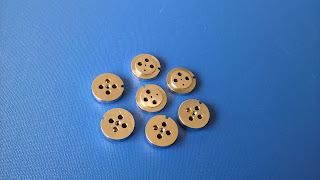P recision parts for the Effect of Changes in Cutting Parameters on
Cutting Temperatures
Precisionmetal parts In
metal cutting operations heat is generated in the primary and secondary
deformation zones and this results in a complex temperature distribution
throughout the tool, workpiece and chip. A typical set of isotherms is shown in
figure where it can be seen that, as could be expected, there is a very large
temperature gradient throughout the width of the chip as the workpiece material
is sheared in primary deformation and there is a further large temperature in
the chip adjacent to the face as the chip is sheared in secondary deformation.
This leads to a maximum cutting temperature a short distance up the face from
the cutting edge and a small distance into the chip
Since
virtually all the work done in metal cutting is converted into heat, it could
be expected that factors which increase the power consumed per unit volume of
metal removed will increase the cutting temperature.Precisionmetal parts Thus an increase in the
rake angle, all other parameters remaining constant, will reduce the power per
unit volume of metal removed and cutting temperatures will reduce. When
considering increase in undeformed chip thickness and cutting speed the
situation is more comples. An increase in undeformed chip thickness and cutting
speed the situation is more complex. An increase in undeformed chip thickness
tends to be a scale effect where the amounts of heat which pass to the
workpiece, the tool and chip remain in fixed proportions and the changes in cutting
temperature tend to be small. Increase in cutting speed, however, reduce the
amount of heat which passes into the workpiece and this increase the
temperature rise of the chip in primary deformation. Further, the secondary
deformation zone tends to be smaller and this has the effect of increasing the
temperatures in this zone. Other changes in cutting parameters have virtually
no effect on the power consumed per unit volume of metal removed and
consequently have virtually no effect on the power consumed per unit volume of
metal removed and consequently have virtually no effect on the cutting
temperatures. Since it has been shown that even small changes in cutting
temperature have a significant effect on tool wear rate, it is appropriate to
indicate how cutting temperatures can be assessed from cutting data.
Precisionmetal partsThe
most direct and accurate method for measuring temperatures in high-speed-steel
cutting tools is that of Wright&Trent which also yields detailed
information on temperature distributions in high-speed-steel tools which
relates microstructural changes to thermal history.Trent has described
measurements of cutting temperatures and temperature distributions for
high-speed-steel tools when machining a wide range of workpiece materials. This
technique has been further developed by using scanning electron microscopy to
study fine-scale microstructural changes srising from over tempering of the
tempered martensitic matrix of various high-speed-steels. This technique has
also been used to study temperature distributions in both high-speed-steel
single point turning tools and twist drills.

没有评论:
发表评论